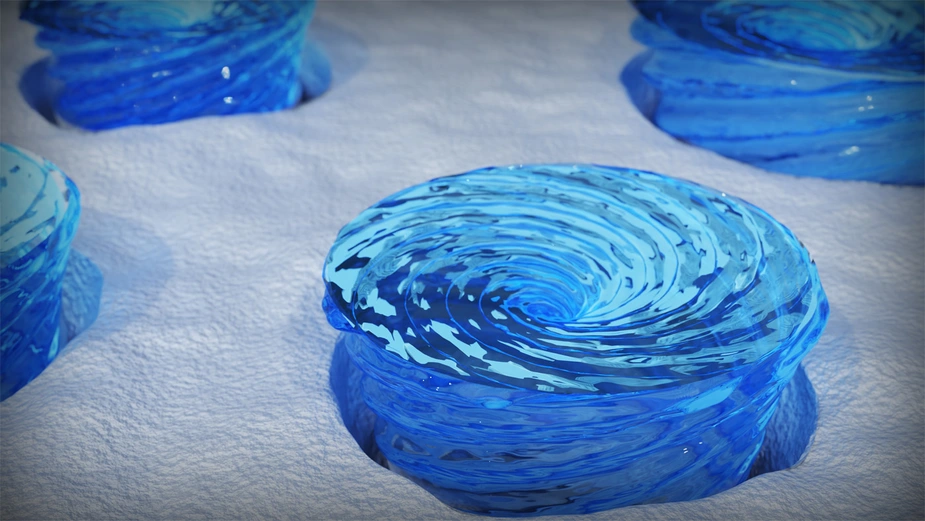Nanoislands on silicon with switchable topological textures
A team at HZB demonstrates that swirling polar textures can be stabilised and switched
Nanostructures with specific electromagnetic patterns promise applications in nanoelectronics and future information technologies. However, it is very challenging to control those patterns. Now, a team at HZB examined a specific class of nanoislands on silicon with interesting chiral, swirling polar textures, which can be stabilised and even reversibly switched by an external electric field.
Ferroelectrics at the nanoscale exhibit a wealth of polar and sometimes swirling (chiral) electromagnetic textures that not only represent fascinating physics, but also promise applications in future nanoelectronics. For example, ultra-high-density data storage or extremely energy-efficient field-effect transistors. However, a sticking point has been the stability of these topological textures and how they can be controlled and steered by an external electrical or optical stimulus.
New perspectives:
A team led by Prof. Catherine Dubourdieu (HZB and FU Berlin) has now published a paper in Nature Communications that opens up new perspectives. Together with partners from the CEMES-CNRS in Toulouse, the University of Picardie in Amiens and the Jozef Stefan Institute in Ljubljana, they have thoroughly investigated a particularly interesting class of nanoislands on silicon and explored their suitability for electrical manipulation.
Nanoislands on silicon
“We have produced BaTiO3 nanostructures that form tiny islands on a silicon substrate,” explains Dubourdieu. The nano-islands are trapezoidal in shape, with dimensions of 30–60 nm (on top), and have stable polarisation domains. “By fine tuning the first step of the silicon wafer passivation, we could induce the nucleation of these nanoislands,” says Dong-Jik Kim, a scientist in Dubourdieu’s team.
Domain patterns studied by PFM
These domains can be reversibly switched by an electric field. The domain patterns were studied using vertical and lateral piezoresponse force microscopy (PFM). “Both the PFM measurement data and the phase field modelling indicate a centred, downward convergent polarisation, which fits perfectly well with the information from scanning transmission electron microscopy (STEM),” says Ibukun Olaniyan, PhD student.
Reversible switching
In particular, the scientists were able to detect a swirling component around the nanoisland axis that causes the chirality. “The texture resembles a swirling vortex of liquid flowing into a narrowing funnel," explains Dubourdieu. “The center down-converging nanodomains can be reversibly switched to center up-diverging nanodomains by an external electric field,” she points out.
“In this work, we have shown that chiral topological textures can be stabilised by shaping nanostructures in an appropriate way,” says Dubourdieu. The ability to create and electrically manipulate chiral, swirling, polar textures in BaTiO3 nanostructures is very promising for future applications.
Publication:
Nature Communications (2024): Switchable topological polar states in epitaxial BaTiO3 nanoislands on silicon
Iurii Tikhonov, Valentin Väinö Hevelke, Sven Wiesner, Leifeng Zhang, Anna Razumnaya, Nikolay Cherkashin, Sylvie Schamm-Chardon, Igor Lukyanchuk, Dong-Jik Kim, Catherine Dubourdieu
DOI: 10.1038/s41467-024-54285-z
Note: This work was partially supported by the ERC Advanced Grant LUCIOLE (101098216).
Contact:
Helmholtz-Zentrum Berlin für Materialien und Energie
Prof. Dr. Catherine Dubourdieu
Institute Functional Oxides for Energy-Efficient IT
+49 30 8062-42868 / -15802
catherine.dubourdieu(at)helmholtz-berlin.de
Dr. Antonia Rötger
Press Officer
+49 30 8062-43733
antonia.roetger(at)helmholtz-berlin.de
Press release HZB, 20 January 2025
